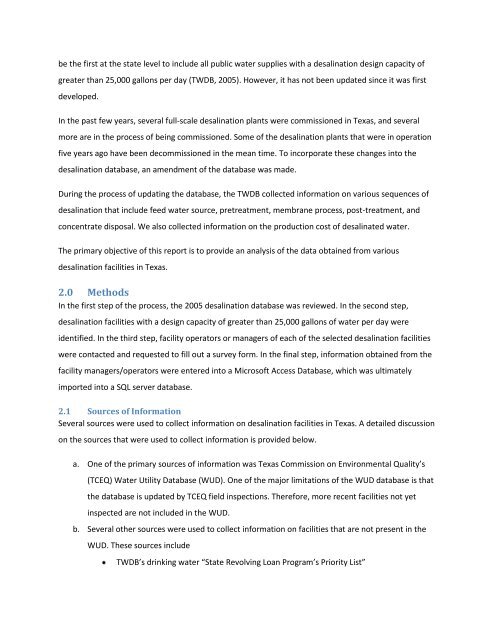Desalination Database Updates for Texas - Texas Water ...
Desalination Database Updates for Texas - Texas Water ...
Desalination Database Updates for Texas - Texas Water ...
Create successful ePaper yourself
Turn your PDF publications into a flip-book with our unique Google optimized e-Paper software.
e the first at the state level to include all public water supplies with a desalination design capacity of<br />
greater than 25,000 gallons per day (TWDB, 2005). However, it has not been updated since it was first<br />
developed.<br />
In the past few years, several full-scale desalination plants were commissioned in <strong>Texas</strong>, and several<br />
more are in the process of being commissioned. Some of the desalination plants that were in operation<br />
five years ago have been decommissioned in the mean time. To incorporate these changes into the<br />
desalination database, an amendment of the database was made.<br />
During the process of updating the database, the TWDB collected in<strong>for</strong>mation on various sequences of<br />
desalination that include feed water source, pretreatment, membrane process, post-treatment, and<br />
concentrate disposal. We also collected in<strong>for</strong>mation on the production cost of desalinated water.<br />
The primary objective of this report is to provide an analysis of the data obtained from various<br />
desalination facilities in <strong>Texas</strong>.<br />
2.0 Methods<br />
In the first step of the process, the 2005 desalination database was reviewed. In the second step,<br />
desalination facilities with a design capacity of greater than 25,000 gallons of water per day were<br />
identified. In the third step, facility operators or managers of each of the selected desalination facilities<br />
were contacted and requested to fill out a survey <strong>for</strong>m. In the final step, in<strong>for</strong>mation obtained from the<br />
facility managers/operators were entered into a Microsoft Access <strong>Database</strong>, which was ultimately<br />
imported into a SQL server database.<br />
2.1 Sources of In<strong>for</strong>mation<br />
Several sources were used to collect in<strong>for</strong>mation on desalination facilities in <strong>Texas</strong>. A detailed discussion<br />
on the sources that were used to collect in<strong>for</strong>mation is provided below.<br />
a. One of the primary sources of in<strong>for</strong>mation was <strong>Texas</strong> Commission on Environmental Quality’s<br />
(TCEQ) <strong>Water</strong> Utility <strong>Database</strong> (WUD). One of the major limitations of the WUD database is that<br />
the database is updated by TCEQ field inspections. There<strong>for</strong>e, more recent facilities not yet<br />
inspected are not included in the WUD.<br />
b. Several other sources were used to collect in<strong>for</strong>mation on facilities that are not present in the<br />
WUD. These sources include<br />
TWDB’s drinking water “State Revolving Loan Program’s Priority List”
















